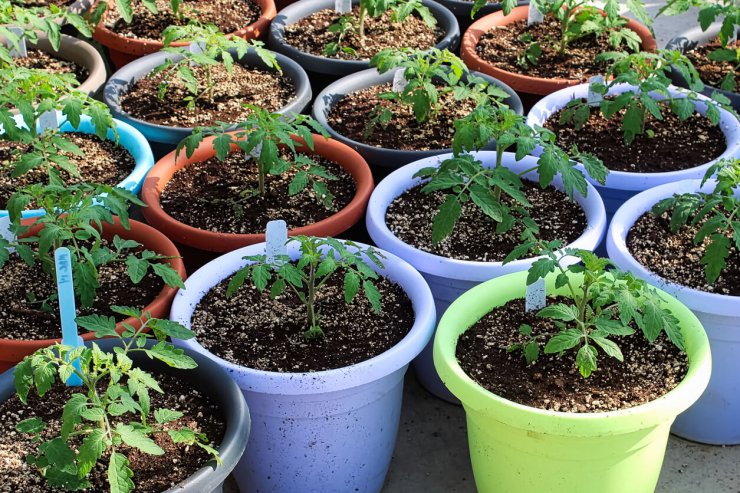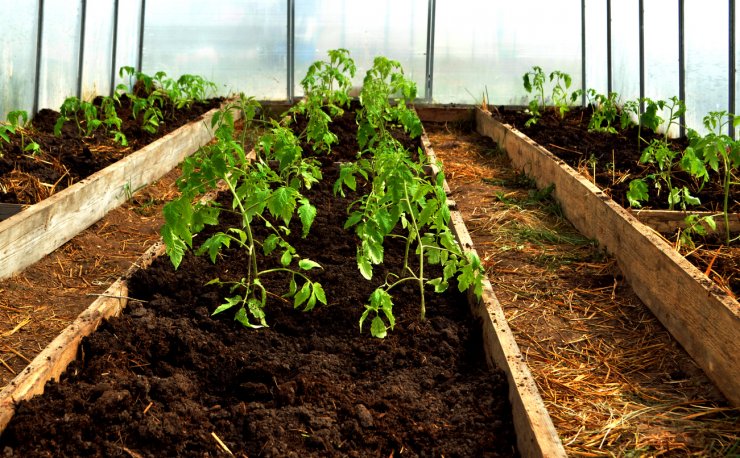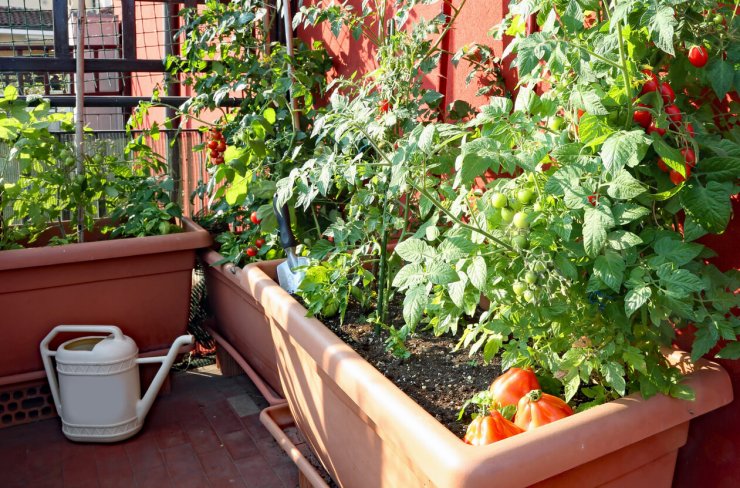
Tomato seedlings in pots
Where to Plant Tomatoes
When first planning your tomato garden, you should consider the type of land you can tend. If you have a large outside plot of land with the right soil and the right conditions for watering and draining, you might have the ideal situation for planting directly in the ground. If, however, your soil is too sandy or not the right composition, you might want to consider planting in raised beds or in containers or pots. Converting your open-land plot into a usable garden might involve a lot of time and effort better spent considering raised beds or containers.
Planting
Tomatoes are generally planted as seedlings, and tomatoes can have a long growing season—sometimes up to 100 days from the day of transplant. So, unless you live in a region with a really long growing season, get your seedlings started early indoors, or get seedlings at your local garden center. Or do both: you’ll have a much broader choice of tomato varieties if you order seeds.
The soil temperature has to be at least 60 degrees F with daytime highs around 75 degrees F and nighttime lows around 65 degrees F. Because seedlings are susceptible to transplant shock, make sure there’s no danger of frost and that you’ve hardened off your seedlings before transplant (if you grew them yourself).
Keep the soil evenly moist during the seed germination period and throughout the growing season. Uneven watering can cause problems for your growing tomato plants.
Plant Spacing
If you’ve sown your seeds directly, thin your seedlings to 24 inches apart when they get to be 4 to 6 inches tall, and you can assess which plants look like they’ll do best. If the seedlings you’re thinning out seem viable, see if you have more space in your garden for them, or consider growing some in containers.
Your rows should be about 2 feet apart to give your plants room to grow and to give yourself some room to maneuver as you harvest. Tomato plants can be several feet tall, particularly indeterminate tomato plants. Because they produce hefty fruits, you’ll want to consider providing them some support in the form of a tomato cage or tying them to a trellis system.
Tomato Companion Plants
Companion planting matches plants with soil and nutrient needs different enough that they help, rather than hinder, the growth of both plants. Good companion plants can help attract beneficial insects and deter pests, from small insects to hungry herbivorous mammals, like rabbits and deer. Companion planting also helps add nutrients to the soil and reduce soil erosion. If you have limited gardening space, companion planting can help you maximize your planting area, giving you another way to squeeze in one more crop.
Tomato’s biggest ally is basil. You already know how intoxicatingly fragrant the basil plant is. That same wonderful scent also happens to attract bees and butterflies, as well as ladybugs, which feed on aphids. It also repels pests like thrips, hornworms, milkweed bugs, flies, and mosquitos, not to mention, some fungal diseases.
Some gardeners also insist that basil and tomato companion planting improves the flavor of your tomatoes. The University of Florida actually conducted a study with a group of volunteers who planted lemon basil and tomatoes together, and the majority agreed that the tomatoes did taste better.
Here’s what we do know. Because basil helps repel pests, tomatoes planted with basil often produce more fruit. And if you’re container gardening, you can get many of the benefits even if they aren’t in the same pot. Just arrange them so they are near each other. In the ground, plant basil and tomatoes about 15 to 20 inches apart.
They’re also easy to plant together since they both have similar needs. Tomatoes and basil require similar amounts of water, and they both love the sun, though basil enjoys some shade also, which the tomato plants can provide for them.
Here’s a larger list of companion plants for tomatoes and the function they serve:
- Basil, dill, oregano, and cilantro: Repel insects, help the tomato plant grow, and make tomatoes taste better.
- Bush beans: Improve pollination and air circulation, and fix the nitrogen in the soil, which tomatoes need.
- Clover: Adds nitrogen to the soil and keep weeds away.
- Collard greens: Use as a trap crop to attract harlequin bugs away from your tomato plants.
- Cowpeas: Use as a trap crop to attract southern green stink bugs away from your tomato plants.
- Mustard greens: Use as a cover crop, then till into the soil before planting to reduce verticillium wilt.
- Radishes: Use as a trap crop to attract flea beetles away from your tomato plants.
- Thyme: The smell fends off adult armyworms so they won’t lay eggs.
Growing Tomatoes in Raised Beds

Raised bed gardening in a greenhouse
Creating raised beds for your tomato garden can be a lot of work the first time you set up your beds, but having raised beds allows you more control over your growing environment. You’ll discover that watering, irrigation, weeding, and even harvesting are much easier, with items closer to your reach and contained in a space that is more manageable than growing in open land. And once you create your raised beds the first time, subsequent years will be easier.
To create nicely contained raised beds for your tomatoes, enclose your raised beds with wooden sides at least 8 inches wide—this will help keep the bed together, be tall enough, and make irrigation easier, too. With raised beds, your garden is less likely to contain the seeds of weeds that are often found in garden soil. You’ll minimize the incidence of weeds overall, which will save you time and effort later. Weeding itself is much easier with raised beds, because you don’t have to get down so far on the ground to remove weeds.
-
- Annual Tip: To optimize the soil in your raised beds, be sure to amend your soil with composting at least once a year—otherwise, your soil can become less productive for your plants.
Growing Tomatoes in Containers
If you don’t have the space for growing in open land or in raised beds—let’s say you live in an apartment with no land of your own for a garden, for example—you can grow tomatoes in containers or pots on your balcony, porch, patio, or deck.
One great advantage to container gardening is the ability to move plants around more easily to maximize their exposure to the sun.
-
- Tip: If you have trouble moving pots around, because they’re too heavy or too bulky, try putting your pots on slightly raised rolling casters so you can more easily move them around your space.
The potted patio tomato is not uncommon—you just have to know the right way to do container gardening for tomatoes. For example, while weeding is much easier with containers, you have to be more vigilant about watering and irrigation as plants can dry out much faster and your tomatoes can be more prone to rot. Plus, containers can lose important soil nutrients throughout the season, so you might need additional fertilizer.

Container gardening
With container gardening for tomatoes, you have to use really big pots or containers—the bigger, the better. Using a 5-gallon pot for one tomato plant is optimal. Also, don’t put other plants, such as herbs, in the same pot with your tomato plant as they’ll drain the soil of nutrients and will compete with your tomato plant for water.
While many other vegetable seedlings are planted at the same depth as their original store-bought mini-containers, tomato seedlings need to be planted deeper. When planting a tomato seedling, remove the bottom few sets of leaves closest to the base of the stem, and plant the seedling deep in a hole at the center of your container or pot. Deep planting will help encourage the roots to grow and will make your plant sturdier when your tomato plant starts growing.
-
- What to do with your container soil at the end of the season: At the end of your tomato-growing season, the soil in your pots will be spent, which means starting over when you create next year’s garden. Dispose of the soil at the end of the season by dumping the soil somewhere else—in another part of your yard or a place where you won’t be growing plants again.
How do you grow your tomatoes—in open land, in raised beds, or in containers? Why do you prefer your method? Please tell us your tips and tricks for creating an awesome tomato garden.


 Previous
Previous


Due to space and sandy soil we plant in raised beds and containers. This year the tomatoes were attacked by green stink bugs. Not happy, got some fruit prior to the attack and have sprayed with homemade bug spray. Will try more later in the summer.